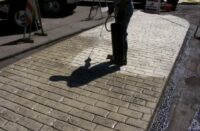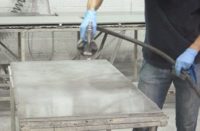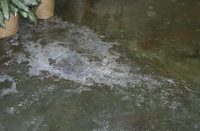
In my experience, sealer issues caused by cold weather don’t occur in the northern “cold climates” but rather in the more temperate or “shoulder” regions that have transition seasons. They also tend to happen in warm climates that may experience cold weather for only brief periods of time.
The inexperience of having to deal with cold weather can lead to a sealer-related callback next spring. No matter where you live or work, having a better understanding of why and how cold temperatures affect sealers may help you someday if you must decide to seal in the cold or hold off for warmer weather.
Heed advice on minimum film-forming temperature
Generally, 50 degrees F (10 C) is the accepted minimum temperature when applying most film-forming concrete sealers and coatings. That number pertains to the temperature of the sealer, as well as the temperature of the air and the surface being treated.
Penetrating sealers that don’t form a film typically can be applied in temperatures below 50 F. No matter the sealer or coating, always refer to the technical data sheet for application guidelines.
All film-forming sealers and coatings have a minimum film-forming temperature (MFFT). When the temperature falls below the MFFT, the sealer film doesn’t come together properly. Typical signs that a sealer was applied below the MFFT include haziness, weak sealer film and/or white dusty powder on the sealer surface.
All sealers and coatings (other than 100 percent solids systems) comprise two primary components — resin and a liquid carrier. Once the sealer is applied, the resin, also known as the solids, creates the protective film through the process of coalescence.
As the temperature drops and gets close to the MFFT, the resin’s ability to coalesce slows down. Once the temperature reaches or drops below the MFFT, coalescence stops and the sealer film won’t form at all.
Note evaporation rate
When temperatures drop, the evaporation rate also slows down. Since most sealers and coatings rely on the liquid carrier evaporating to properly dry, this slowing evaporation rate also affects film formation. It’s important to note that evaporation rates vary depending on the type of solvent in the sealer.
For example, water will evaporate much slower than acetone, so cold temperatures typically affect water-based sealers more than solvent-based sealers. Note: Switching to a solvent-based sealer may allow you a little more breathing room if the temperatures are hanging around the 50 F mark. I am never one to recommend taking undue risks, but I also realize that real-world pressures exist, and many times you need to just get it done.
Other factors to weigh in
Since sealers or coatings are being applied to a substrate, the temperature of the substrate and the surrounding air are also important. Key cold weather environmental and substrate factors to consider are condensation, dew point, moisture traps and surface temperature gradients.
Condensation: Water vapor condenses and forms liquid water when it comes in contact with a cold surface. A great example is steam in a hot shower condensing into water when it hits the cold tile.
This same process occurs when the temperature drops and moisture in the air hits cold concrete. The concrete may look dry, but if the humidity is high the surface could be saturated. This phenomenon is known as surface-saturated dry, and it can lead to sealer adhesion and haze issues.
Condensation is more of an issue in the fall and spring when there are large temperature swings. It’s best to wait until the surface and air temperatures rise and even out.
Dew point: This is when the air reaches a temperature where water begins to condense and changes from vapor to liquid. An important environmental factor, the dew point should be monitored when sealing in cold temperatures.
If the humidity is high and the temperature is below the dew point, you will have water condensing on the concrete. Sealing isn’t recommended until the temperature rises and the substrate dries.

Moisture traps: During cold weather, these are places where moisture can get trapped. Consequently, they may not dry as fast or may be a different temperature than the surrounding areas. Common moisture traps include cracks, joints, cold joints and raised decks (areas where cold air can get below).
Surface temperature differences: These are changes in temperature across a surface base caused by other factors. Examples include temperature differences on raised slabs compared to slabs on grade, or interior concrete close to walls or doors that may be colder or warmer depending on the exterior temperature.
Just because the project may be inside doesn’t mean cold temperature issues go away. I’ve seen my fair share of interior sealer failure caused by cold slabs. Just because the air is warm doesn’t mean the surface is warm, especially in the winter months.

Accuracy is important
When sealing in cold weather, it’s important to have accurate temperature readings. Getting accurate air temperature is easy — it’s just a click away on a smart phone or a quick glance at a temperature reading in a car. Getting an accurate surface temperature requires an infrared thermometer. These are readily available at most big box stores, online or auto parts stores. All you do is point and shoot!
I often hear from applicators who say they have been applying sealers successfully for years at air temperatures between 35 and 45 degrees F. But how successful? A sealer applied close to the minimum film-forming temperature may look fine for a while, but six to 12 months later I’d go back and see how well it’s performing. Every project has different environmental factors to consider, but I still suggest using the 50-degree rule as a safe guideline.
Choosing to seal concrete at temperatures below 50 degrees substantially increases the risk of premature sealer failure. Remember, if you’re considering sealing in cold temperatures, the only remedy for cold weather sealer issues is almost always stripping and resealing which is labor-intensive and costly.
Questions from Readers
Question
I spilled hydrochloric acid on an area of about 2 sq. ft. on my garage floor. How do I reseal the area?
Answer from Concrete Decor















